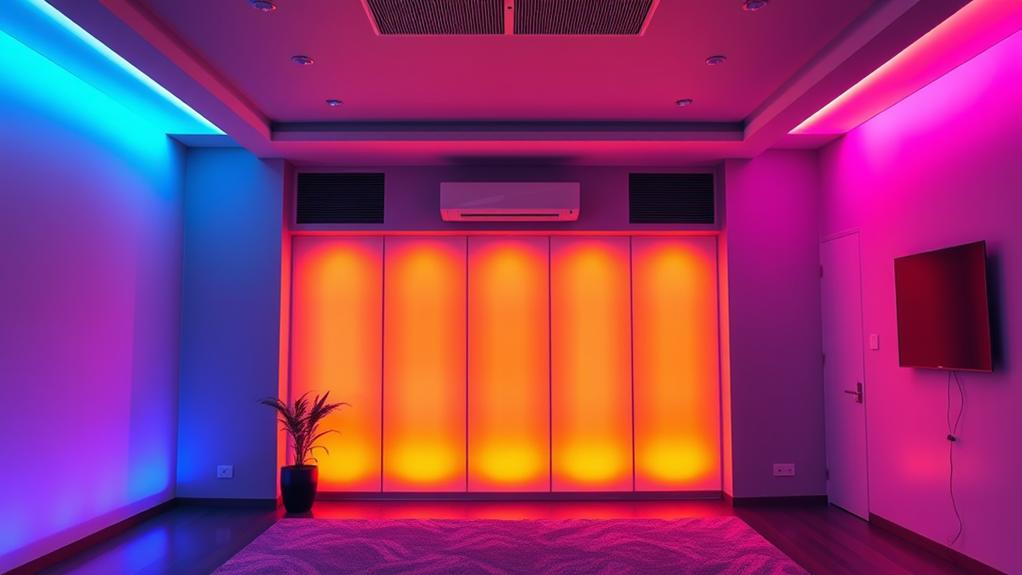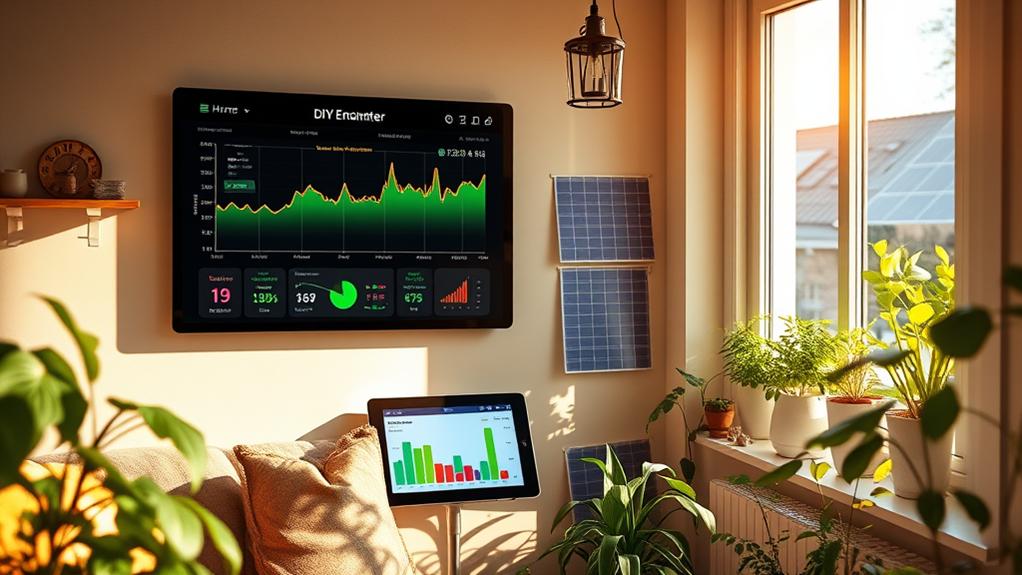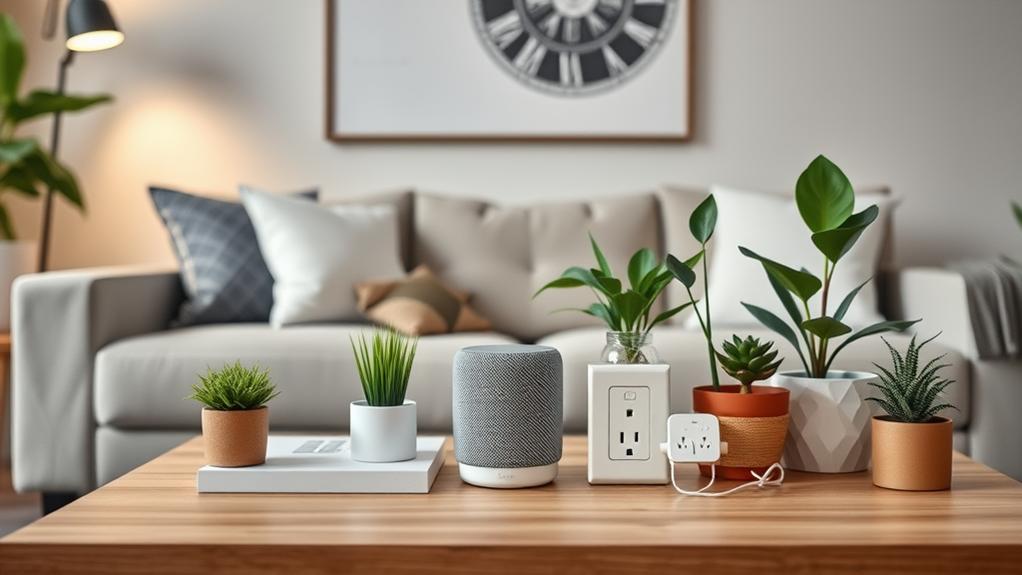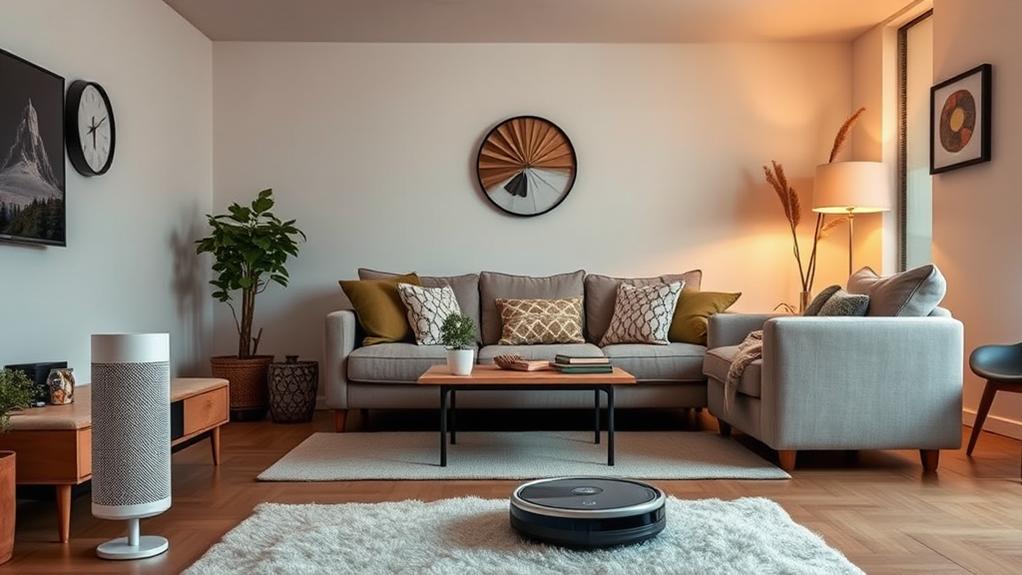Just as Da Vinci's inventions transformed the world, today's intelligent lighting systems are redefining how we experience our environments. You might wonder what truly sets these systems apart from traditional lighting. Is it the ability to sense your presence, or perhaps the seamless integration with your daily routines? Understanding the underlying features and technologies can reveal a lot about their potential impact on your life. The question remains: how do these elements come together to create a truly intelligent lighting experience?
Key Features of Smart Lighting
Smart lighting systems come packed with features that enhance both convenience and energy efficiency. One of the standout features is remote control, allowing you to operate your lights from anywhere using a smartphone app or voice command. You'll love how easily you can adjust brightness or change colors without getting up.
Another key feature is scheduling. You can set your lights to turn on or off at specific times, which not only saves energy but also adds an extra layer of security when you're away from home.
Motion sensors are also a fantastic addition; they can automatically turn lights on when you enter a room and off when you leave, ensuring that no energy goes to waste.
Integration with home automation systems makes these smart lights even more appealing. You can sync them with other smart devices, creating a seamless experience.
Additionally, many smart lighting systems offer customizable scenes. You can create the perfect ambiance for any occasion with just a tap or voice command.
With these features, you're not just upgrading your lighting; you're transforming your entire living space into a more efficient and enjoyable environment.
Benefits of Intelligent Systems
With intelligent lighting systems, you can enjoy a myriad of benefits that go beyond mere convenience.
These systems not only elevate your living space but also enhance your overall quality of life. By incorporating smart technology, you'll experience energy efficiency, increased comfort, and improved security.
- Energy Savings: Intelligent lighting adjusts automatically based on occupancy and natural light levels, which helps reduce your electricity bill and lower your carbon footprint.
- Personalized Ambiance: You can customize lighting settings to suit your mood or activity. Whether you're hosting a dinner party or winding down for the night, you have full control over the atmosphere.
- Enhanced Security: With smart lighting, you can simulate your presence at home by scheduling lights to turn on and off. This deters potential intruders and gives you peace of mind when you're away.
Types of Smart Lighting Solutions
Many homeowners are discovering the diverse types of smart lighting solutions available today. One popular option is smart bulbs. These bulbs connect to your home Wi-Fi, allowing you to control brightness and color through your smartphone or voice assistant. You can easily adjust the ambiance of any room with just a few taps or commands.
Another solution is smart lighting systems, which often include fixtures or strips that can be integrated into your existing setup. These systems can be programmed for various scenarios, like movie nights or hosting friends, creating the perfect atmosphere effortlessly.
Smart switches are another fantastic choice. They replace traditional dimmer switches and let you control your lights from anywhere, even when you're not home. Plus, some smart switches offer energy monitoring capabilities, helping you track usage and save on electricity bills.
Lastly, there are motion-sensor lights. These automatically turn on when they detect movement, enhancing security and convenience. You can install them in hallways, garages, or entryways for added safety.
With so many options, you can tailor your smart lighting solution to fit your lifestyle perfectly.
Essential Components for DIY Projects
To tackle a DIY smart lighting project, you'll need a few essential components to guarantee everything runs smoothly.
First, you'll want a reliable smart bulb or LED strip that's compatible with your chosen smart lighting system. These bulbs not only provide customizable color options, but they also allow remote control through your smartphone or voice assistant.
Next, a smart hub or bridge is crucial for connecting your devices. This hub acts as the central point where all your smart products communicate, ensuring seamless operation.
Finally, consider adding motion sensors or smart switches to enhance your setup. These will allow you to automate your lighting based on your movements or set schedules, providing convenience and energy savings.
Here's a quick list of essential components for your DIY smart lighting project:
- Smart bulbs or LED strips
- Smart hub or bridge
- Motion sensors or smart switches
Integration With Home Automation
Seamless integration with home automation systems can transform your living space into a smart haven. Imagine controlling your lighting with just your voice or a simple tap on your smartphone. When your lighting system syncs with your home automation setup, you gain the ability to create customized scenes that fit your mood or activities.
Whether it's movie night or a cozy dinner, you can adjust the brightness and color temperature effortlessly. You'll also appreciate the convenience of scheduling your lights to turn on or off at specific times, enhancing your security when you're away.
With motion sensors, your lights can automatically illuminate as you enter a room, making your home feel more welcoming. Furthermore, integration with other smart devices, like thermostats and security cameras, allows your lighting to respond to various scenarios.
For example, if your security system detects movement, the lights can flood your space with brightness, deterring potential intruders. Incorporating intelligent lighting into your home automation system not only elevates your daily experience but also enhances the overall functionality of your living space.
Get ready to enjoy the convenience and control that comes with a truly intelligent lighting system.
Energy Efficiency and Cost Savings
Embracing an intelligent lighting system can lead to significant energy efficiency and cost savings. By adopting smart technologies, you can optimize lighting usage based on your specific needs.
For instance, automated sensors adjust the brightness depending on natural light levels or occupancy, which means lights won't be on when they're not needed. This not only lowers your energy bills but also extends the lifespan of your lighting fixtures.
Consider these key benefits of an intelligent lighting system:
- Reduced Energy Consumption: Smart systems use less energy, thanks to features like dimming and scheduling.
- Lower Maintenance Costs: With longer-lasting LED lights and efficient control systems, you'll spend less on replacements and repairs.
- Enhanced Control: You can monitor and adjust your lighting remotely, ensuring that energy isn't wasted when you're away.
Investing in an intelligent lighting system isn't just about convenience; it's a smart move for your wallet and the environment.
User-Friendly Control Options
Steering an intelligent lighting system becomes effortless with user-friendly control options that cater to your preferences. You'll find that intuitive interfaces make managing your lighting as simple as a swipe or a tap.
Whether you're using a smartphone app, a voice assistant, or a sleek wall panel, you can easily adjust brightness, color, and schedules to suit your daily routine.
Imagine walking into a room and having the lights automatically adjust to your desired settings. With smart sensors, your space responds to your presence, providing the perfect ambiance without you lifting a finger.
Customization doesn't stop there; you can create scenes for various activities—be it relaxing, working, or entertaining—tailoring the atmosphere to your mood.
Moreover, many systems allow you to control multiple fixtures simultaneously, making it easy to manage your entire home's lighting from one central hub.
Integration with smart home systems enhances this convenience, allowing you to sync your lighting with other devices for a cohesive experience.
With all these options at your fingertips, you'll find that managing an intelligent lighting system not only enhances your comfort but also elevates your lifestyle.
Future Trends in Smart Lighting
As technology rapidly evolves, smart lighting is consistently becoming more sophisticated and integrated into our daily lives.
You'll find that the future of smart lighting holds exciting possibilities, enhancing convenience, energy efficiency, and user experience. Here are a few trends to keep an eye on:
- Adaptive Lighting: Future systems will adjust automatically based on occupancy, time of day, and natural light levels, ensuring ideal brightness while saving energy.
- Integration with IoT: Smart lighting will seamlessly connect with other smart home devices, creating a cohesive ecosystem that enhances your overall living experience. Imagine your lights adjusting when your thermostat changes or when your security system activates.
- Health and Wellbeing: Expect innovations focused on improving your well-being, like lighting that mimics natural daylight patterns, promoting better sleep and productivity.
These trends indicate that smart lighting isn't just about illumination; it's about creating an environment that adapts to your needs and enhances your lifestyle.
As you explore these advancements, you'll appreciate the transformative power of intelligent lighting in your home and beyond.
Conclusion
In the ever-evolving landscape of home technology, intelligent lighting systems shine like stars in the night sky, illuminating your life with convenience and efficiency. By embracing these smart solutions, you're not just brightening your space; you're crafting an atmosphere tailored to your needs. As you integrate them into your home, think of each light as a brush stroke on a canvas, painting a masterpiece of comfort, security, and energy savings for you and your family.











